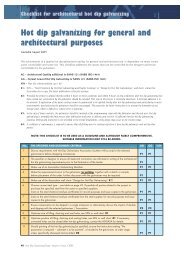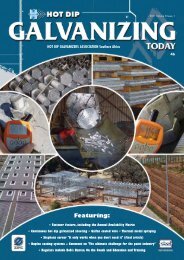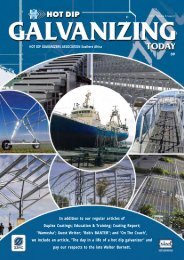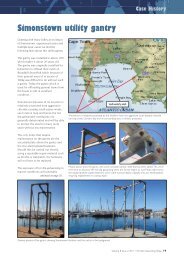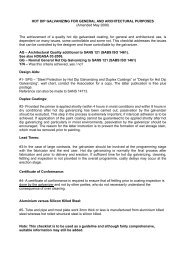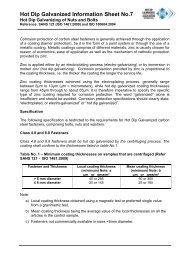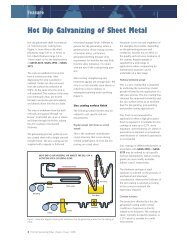Fasteners - hdgasa
Fasteners - hdgasa
Fasteners - hdgasa
Create successful ePaper yourself
Turn your PDF publications into a flip-book with our unique Google optimized e-Paper software.
<strong>Fasteners</strong><br />
Pre lubricated nuts (with<br />
molybdenum disulphide)<br />
There may be a misconception, since<br />
there has been so much talk and use<br />
of pre-lubricated nuts that this is a<br />
new standard requirement. Whilst we<br />
recommend pre lubricated nuts for the<br />
reason there is a tested coefficient of<br />
friction that can be relied upon, this is<br />
by no means a general requirement.<br />
EN14399 specifically makes reference<br />
to surface finish as processed,<br />
meaning lightly oiled, or as agreed<br />
between purchaser and manufacturer.<br />
Nevertheless, appropriate lubrication<br />
is required during installation,<br />
particularly with hot dip galvanized<br />
bolts. In the case of no lubrication,<br />
galling will take place and in<br />
laboratory testing, we have established<br />
the potential of failure due to<br />
torsional tension.<br />
In the case of the turn of nut method<br />
of fastening in the B&N assembly<br />
with lubrication, where potentially<br />
25% to 35% additional clamp can be<br />
obtained than required by the<br />
standard without lubrication, the<br />
likelihood of thread failure is almost<br />
100%. All the torque value will be<br />
absorbed by the galling effect of the<br />
soft galvanized layer and if the bolt<br />
has not started to fail due to torsion<br />
tension, the correct clamp will not<br />
have been achieved and a loose bolt<br />
left in place, with future potential<br />
failure consequences.<br />
We really do recommend pre<br />
lubricated nuts that have been baked<br />
to a dry condition. The advantages; it<br />
avoids the wrong lubricant choice,<br />
incorrect lubricant application is<br />
avoided, the risk of attracting grit on<br />
nuts during installation due to sticky<br />
lubricant is reduced and, of<br />
paramount importance, certification<br />
of the coefficient of friction is<br />
supplied, together with<br />
recommended torque values.<br />
Installation equipment<br />
Many bolters rely on the torque<br />
wrenches having been recently<br />
calibrated. One of the over looked<br />
checks that needs to be undertaken<br />
is the wrench verification. This<br />
should take place on the day the<br />
wrench will be used by testing at<br />
least 3 bolts of the diameter to be<br />
installed with that wrench on that<br />
day. The verification takes place<br />
using a static torque meter. The<br />
reason for this verification is that<br />
calibration can change if, for<br />
example, the wrench was dropped.<br />
We have observed that many<br />
installers do not do verify their<br />
equipment, nor do they have the<br />
required equipment to undertake the<br />
verification.<br />
Need it be said that hammer drill type<br />
impact wrenches are an absolute no!<br />
Their calibration cannot be verified.<br />
continued on page 6...



